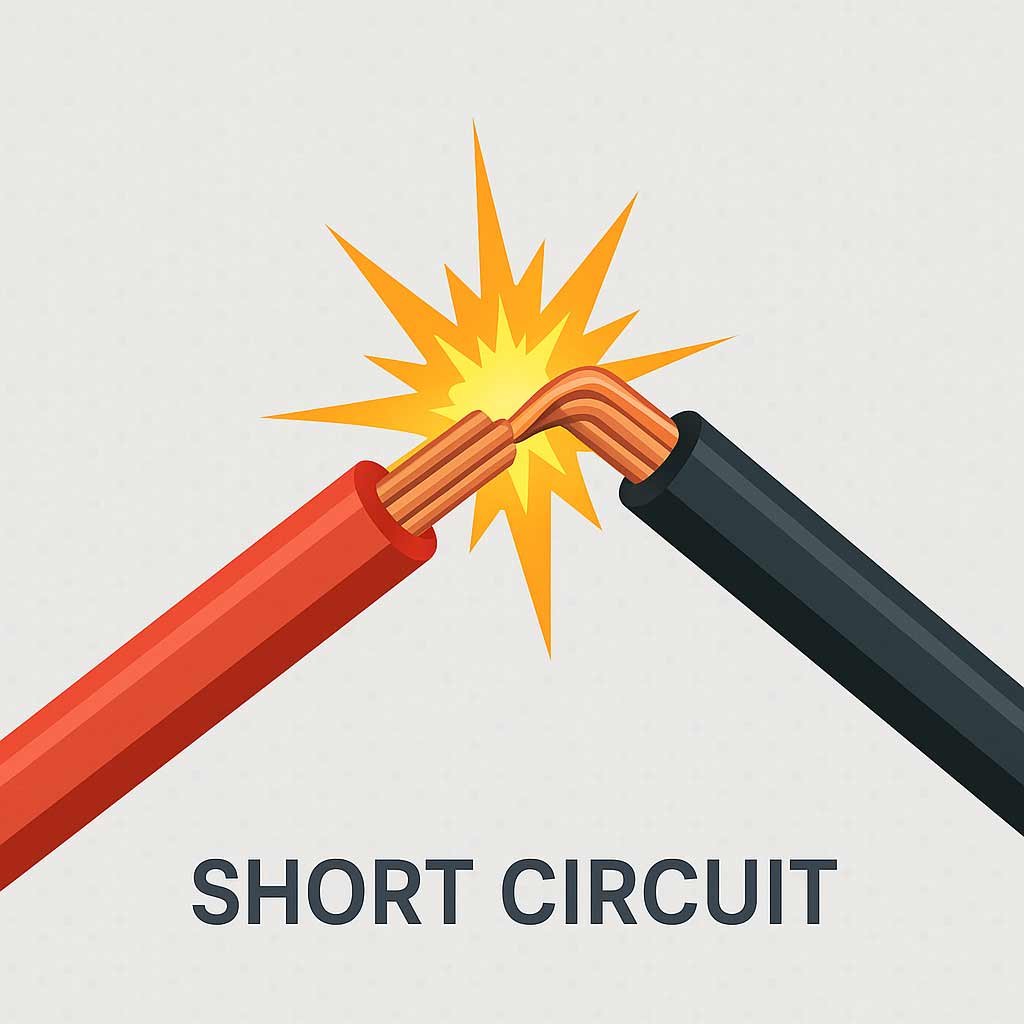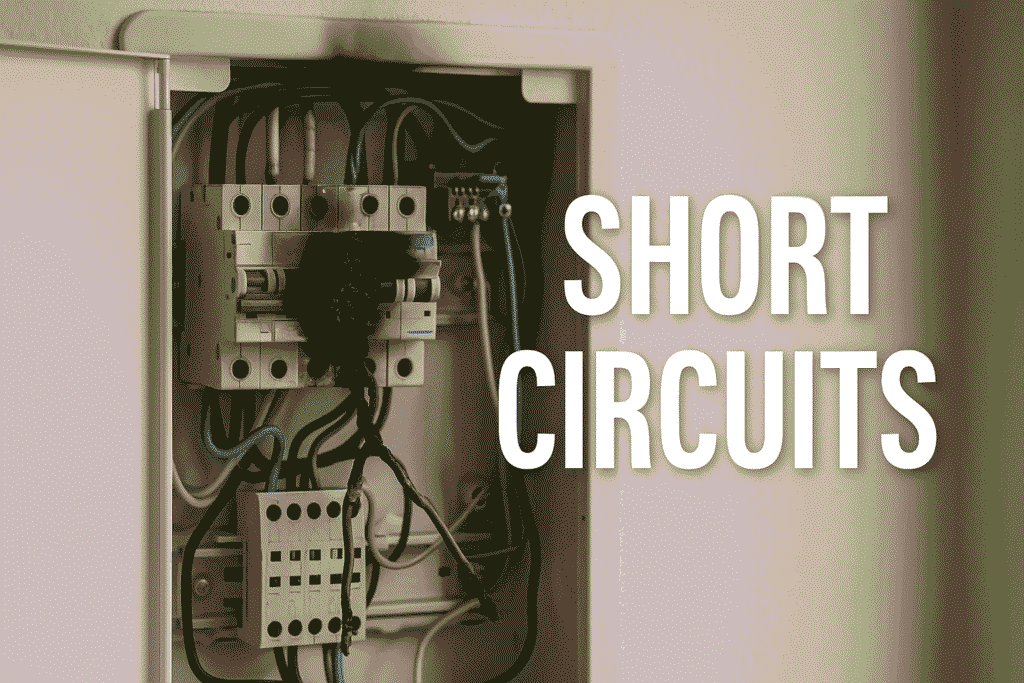A short circuit is one of the most common and dangerous electrical issues that can occur in any electrical system. It happens when there is an unintended connection between two points with different potential values in an electrical circuit (ex, Live cable touches Neutral cable), which allows a large current to flow through a path of little or no electrical resistance. This sudden surge of current can cause significant damage to the electrical components, overheating, fires, or even explosions if not properly managed.
How Does a Short Circuit Happen?
In a properly functioning electrical circuit, the current flows through a predetermined path, powering devices or loads. However, when a short circuit occurs, the current deviates from this path due to a fault or damage in the wiring or components.

Causes of Short Circuits:
- Damaged Insulation: Wires are covered with insulating material to prevent unintended contact. If this insulation gets worn down, cut, or deteriorates, it can expose the conductive material, allowing the current to escape from its designated path.
- Faulty Wiring: Poor-quality wiring or incorrect installation can lead to a short circuit. Loose or frayed wires can easily come into contact with each other or with conductive materials, causing a short.
- Overloading: Connecting too many electrical devices to a single circuit can lead to overheating, which may melt the insulation or cause other components to fail, resulting in a short circuit.
- Moisture and Water Damage: Water is a conductor of electricity, so if moisture gets into electrical outlets, switches, or appliances, it can cause a short circuit by creating a conductive path where none was intended.
- Metallic Contact: Metal objects, such as nails or screws, can sometimes penetrate electrical wiring and create a direct connection between the live wires, leading to a short circuit.
Types of Short Circuits
There are two main types of short circuits:
- Normal Short Circuit: This occurs when the hot (live) wire directly touches a neutral wire. The resistance drops, allowing a large current to flow. The excess current can overload the circuit, tripping the circuit breaker or blowing a fuse.
- Ground Fault: This type of short circuit happens when the hot wire comes into contact with a grounded component, such as the metal casing of an appliance or an earth wire. A ground fault is especially dangerous because it can lead to electrical shock and pose serious hazards to both equipment and personnel.
Effects of a Short Circuit
A short circuit can have several consequences, including:
- Overheating and Fires: Since the current flows through a path with minimal resistance, the wires and components can overheat quickly. This excessive heat can cause insulation to melt, potentially sparking an electrical fire.
- Equipment Damage: Electrical devices and appliances are designed to handle a specific current range. A short circuit can expose them to a sudden surge of high current, which can damage their internal components or render them completely unusable.
- Tripping of Circuit Breakers: Circuit breakers are designed to detect overcurrent situations caused by short circuits. When they sense the excess current, they “trip” and cut off the power supply to prevent further damage. Although this is a protective measure, frequent short circuits can lead to unnecessary downtime and system failures.
Preventing Short Circuits
While short circuits can be hazardous, proper precautions and regular maintenance can prevent them. Here are some tips:
- Inspect Wiring Regularly: Conduct regular inspections of your electrical wiring to check for wear, fraying, or exposed wires. Replace or repair damaged wiring immediately to prevent potential short circuits.
- Use Properly Rated Components: Ensure that all electrical components, such as circuit breakers, fuses, and wiring, are rated correctly for the electrical load they will handle. Using undersized wires or overloading a circuit increases the risk of a short circuit.
- Install Ground Fault Circuit Interrupters (GFCIs): GFCIs are specialized circuit breakers that quickly shut off the power if they detect a ground fault. They are commonly installed in wet areas like kitchens and bathrooms where water contact is more likely.
- Avoid Overloading Circuits: Distribute electrical loads evenly across circuits and avoid plugging too many devices into a single outlet. This reduces the likelihood of overheating and subsequent short circuits.
- Proper Moisture Control: Keep electrical components dry and ensure that water does not come into contact with your electrical systems. Use waterproof outlets or cover plates in areas prone to moisture.
How to Identify a Short Circuit
There are a few signs that may indicate the presence of a short circuit:
- Tripped Circuit Breakers: If a circuit breaker trips immediately after you turn on a device or appliance, this may be an indication of a short circuit.
- Burning Smell: If you smell something burning near electrical outlets or appliances, this could mean that the wires are overheating due to a short circuit.
- Sparks or Smoke: Any visible sparks or smoke coming from an outlet, switch, or appliance is a sure sign of a short circuit and should be addressed immediately by turning off the power.
- Discolored Outlets: Outlets that are discolored or charred are an indication that overheating has occurred, which could be caused by a short circuit.
What to Do if a Short Circuit Happens
If you suspect a short circuit, here are the steps to take:
- Turn Off the Power: Immediately switch off the circuit breaker for the affected area to cut off the power supply and prevent further damage.
- Unplug Devices: Disconnect all devices and appliances from the circuit to avoid additional risks.
- Call an Electrician: For safety, it’s essential to contact a licensed electrician to locate the source of the short circuit and perform the necessary repairs.
- Do Not Touch Exposed Wires: Never attempt to handle exposed or live wires, as this can lead to electrical shock.
Conclusion
Short circuits are dangerous electrical faults that can cause serious damage, including fires, equipment destruction, and personal injury. However, with proper care, maintenance, and awareness of your electrical system, you can minimize the risk of a short circuit occurring. Regular inspections, using correctly rated components, and practicing good electrical safety habits will help ensure a safe and efficient electrical system in your home, business, or industrial setting.

Pingback: Step vs Touch Potentials: Electrical Shock Prevention Guide
Pingback: Understanding Continuity Testing: A Step-by-Step Guide